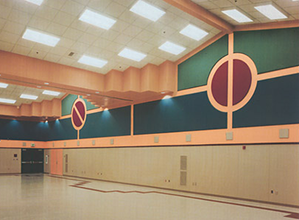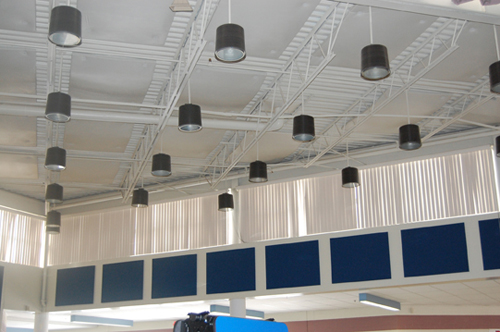How to Calculate Reverberation Time
Measuring the reverberation time of a space is a good way to identify a noise control problem. If your large open space is plagued by echo and difficulty understanding speech, you may have a reverberation problem. Here we will discuss how to calculate the reverberation time for your multi-purpose use space.
Acoustic Calculation
The first step to calculate the reverberation time is to calculate the Sabins with the below equation.
Formula for Sabins:
a = Σ S α
Where:
Σ = sabins (total room absorption at given frequency)
S = surface area of material (feet squared)
α = sound absorption coefficient at given frequency or the NRC
After we calculate a, we can then use the Sabine Formula to calculate the reverberation time.
Sabine Formula:
RT60 = 0.049 V/a
Where:
RT60 = Reverberation Time
V = volume of the space (feet cubed)
a = sabins (total room absorption at given frequency)
In an existing room, you can go on site and measure the reverberation time using a loud speaker and a sound level meter. You can also calculate the reverberation time using the Sabins Formula created by Wallace Clement Sabine. This equation is based on the volume of the space and the total amount of absorption within a space. The total amount of absorption within a space is referred to as sabins. It is important to note that the absorption and surface area must be considered for every material within a space to calculate sabins.
To obtain the sabin values, we use the volume (length x width x height) of the room and the materials of the surfaces. The table below provides the sabins at each octave band frequency for common construction materials.
| Location | Material | Absorption Coefficient (a) or Sabins Octave Band Center Frequencies |
|||||
| 125 Hz | 250 Hz | 500 Hz | 1000 Hz | 2000 Hz | 4000 Hz | ||
| All Walls | Gypsum Board | 0.29 | 0.10 | 0.06 | 0.05 | 0.04 | 0.04 |
| Ceiling | Metal Deck | 0.05 | 0.04 | 0.03 | 0.03 | 0.02 | 0.01 |
| Floors | Concrete Painted | 0.01 | 0.01 | 0.02 | 0.02 | 0.02 | 0.02 |
Then we can add sound absorption to the calculation.
| Location | Material | Absorption Coefficient (a) or Sabins Octave Band Center Frequencies |
|||||
| 125 Hz | 250 Hz | 500 Hz | 1000 Hz | 2000 Hz | 4000 Hz | ||
| All Walls | Gypsum Board | 0.29 | 0.10 | 0.06 | 0.05 | 0.04 | 0.04 |
| Ceiling | Metal Deck | 0.05 | 0.04 | 0.03 | 0.03 | 0.02 | 0.01 |
| Floors | Concrete Painted | 0.01 | 0.01 | 0.02 | 0.02 | 0.02 | 0.02 |
| Ceiling | Acoustic Baffles | 0.27 | 0.65 | 1.06 | 1.16 | 1.14 | 1.12 |
This provides us with the reverberation time before and after treatment. It also allows us to understand the amount of material to add to the space to achieve our noise reduction goal.
Call eNoise Control for assistance calculating the reverberation time of your space. We will help you determine the different sound absorption options and how much your space needs.





